At the beginning of the article, the author would like to make two reservations.
1. May the dear reader forgive me, I will talk about the real Ukraine and the real world around it. The author worked for many years in high-quality analytical structures (before changing the profile and direction of life). And at the same time, in principle, he treats myths with great interest as a source of insights :) and other valuable observations. But domestic myths about ourselves sometimes cost too much for us. From a humble author's statement.
2. What the author writes may knowingly be disliked by many readers. Most people in Ukraine are not vaccinated against coronavirus and may mistakenly perceive the author's position as purely provocative or critical in relation to their personal decisions. But this is not the case. The author's position is analytical, distanced from controversy around the benefits or harms of vaccination.
Vaccination is interesting in that it produces massive amounts of data. Bigger than even good traditional international polls. And, at the same time, quite transparent data - and not only for the interested analyst, but also for the interested general reader.
With regard to vaccination, from my point of view, everyone has the right to make their own decisions. Nobody knows everything about vaccination. Not all for, not all against. And this uncertainty, "ignorance of everything" is a typical feature of the world around man from ancient times to the present day.
At the same time, mankind, those in power, elites, the population in general, have always had to respond to challenges. Contrary to the "ignorance of everything" mentioned above. Basically, to react - more or less pragmatically using what was known at a particular moment and seemed to be the best solution at that moment.
Well, here we will try to use the data that we have at the moment :) It's time to talk about a working hypothesis.
The author's working hypothesis boils down to the fact that if the population perceives itself to be a part of the developed global world, it will tend to respond to significant challenges in the same way as the developed global world responds.
It is clear that there are nuances. For example, from a purely quantitative point of view, it is easier to reach the population of Bahrain with vaccinations than the USA or India. But this does not mean that the trends are generally not visible. And some small countries, including the post-Soviet space, demonstrate many times lower rates of vaccination.
It is also understandable that developed countries began to vaccinate earlier because they were in no hurry to share vaccines. Nevertheless, we see that many of the developing countries have already managed to catch up with them (even overtake them, if you look at a more complete list of countries here: https://ourworldindata.org/covid-vaccinations ).
This allows, for example, to assume that the main reason for the low percentage of vaccinations in Ukraine (the numbers will be lower) today is not the lack of vaccines or the possibility of being vaccinated, but the attitude of the population to vaccination.
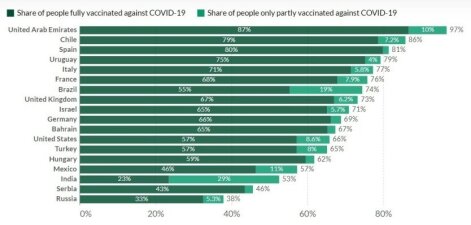
Proportion of vaccinated persons as of 30 October 2021 in selected countries.
Source: https://ourworldindata.org/covid-vaccinations
Again, we do not assess whether this attitude is “correct” or not. Only if it is in the same trend with the developed global world or not.
By the way, in principle, the attitude of officials to the process and to the organization of processes (from vaccination itself to informing) can be conventionally referred to the “attitude of the population”. But the author would not like to delve into this topic in this case. In this regard, we will pay attention only to the coincidence of the country's reaction with the global trend and to the speed of its reaction to the global challenge.
The “locomotives of progress” in the West and in the East can respond to global challenges by engaging various institutions, but both seek to respond as quickly as possible. This illustrates the very nature of competition in today's fast and fiercely competitive global world.
Now I invite the dear reader to look at the second picture. It is obvious that the myths carefully cultivated in Ukraine about "great and tireless integration" too obviously do not coincide with such "pictures from space" :) of objective reality .
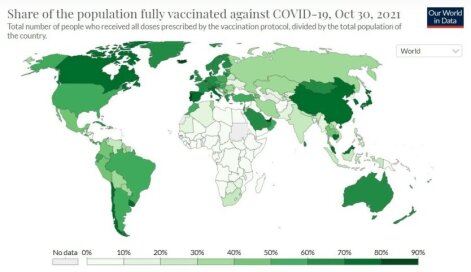
Fully vaccinated population as of October 30, 2021. The global picture.
Source: https://ourworldindata.org/covid-vaccinations
Does this picture also have some non-literal, partial, but still visible connection with the level of poverty (tied not only to the intrigues of all kinds of "imperialists", "reptilians" and others like them, but also to the mentality, the level of organization tied to it? processes and the degree of real, non-fictional openness to the world)? Let the reader guess for himself.
Now let's look at the situation in the regions of Ukraine and note which regions are more involved in global trends (and, accordingly, they themselves are more inclined to include and promote Ukraine into the global world)x`, and which ones are less.
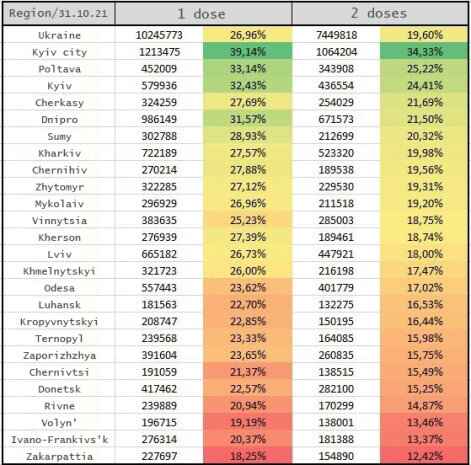
Vaccination by regions of Ukraine
Source: Facebook post of Evgeny Istrebin.
For people familiar with sociology in Ukraine, and not oriented to myths, there are no special discoveries in the picture. Kyiv is the most open city to powerful trends in the country. What is common among capitals. And this, inter alia, affects the adjacent area and adjacent regions.
Further more interesting. It can be assumed, that...
The industrial, scientific, educational potential of large cities - regional centers (for example, Dnipro and Kharkiv) seems today to be a more determining factor of integration than geography itself . They have their own "gravity", independent of the direct influence of Kiev, but they themselves influence the neighboring regions less noticeably.
Lviv region lags behind these centers, but ahead of, for example, Odessa. It is clear that Odessa and the region are “two big differences”. But favorite local myths and reality are also “two big differences” :)
I will also cautiously assume that industrial, scientific, educational potential may influence the "mental response" :) more than logistics . Neither the proximity of the sea and sea transportation, nor the proximity of the border and cross-border movements, nor even the most modern cargo traffic of airports are integrated as much as developed technical and humanitarian thought and the direct involvement of the population in large-scale projects (advanced for a certain time) are integrated :) just a little joke :)
Below is the illustration of airport data for a thoughtful reader. Naturally, pre-pandemic.
Passenger traffic at Ukrainian airports.
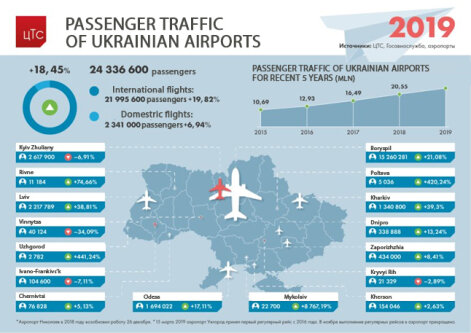
Dec 2019
Source: Center for Transport Strategies with reference to the State Aviation Service.
Let me make a reservation, dear reader, for me, as a psychologist, it is quite obvious that a region is not a specific person :) Even if this person comes from a region that tends to be closed or open, he himself may gravitate towards a different mentality. The same applies to the inhabitants of the countries. This does not diminish the value of indirect data when it comes to millions or billions of people in countries and regions.
Now I would invite you to look at a couple of figures regarding age differences .
Moreover, I will immediately make a reservation that the value of such data in the future may fall due to the spread of vaccination measures, which its critics attribute to compulsory. So far, the world (it is difficult to judge about China and a number of other closed countries) is dominated by data related to more or less "amateur" :) vaccination of the population. But the graphs (including for Ukraine, see below) have long demonstrated sufficient stability to draw conclusions.
Take France as a fairly neutral example of a large European country.
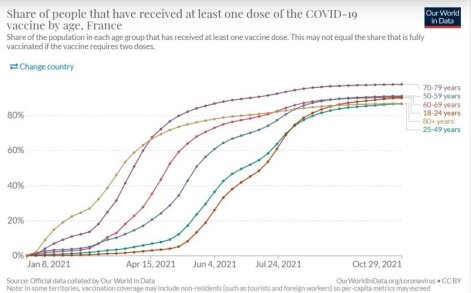
Vaccination by age, France.
Source: https://ourworldindata.org/covid-vaccinations
In general, all age groups show a high interest in vaccination (at least 1 dose). Moreover, we do not see low interest in vaccination even among the population aged 18-24 years. But we see a very high interest among the population aged 70-79 years. This is understandable because of the high risks for the elderly population. After 80, interest is somewhat lower, but not significantly.
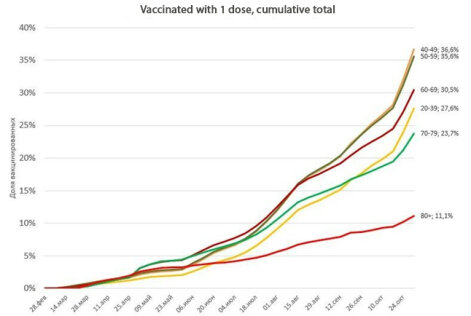
Vaccination by age Ukraine.
Source: Facebook post of Evgeny Istrebin.
Ukrainian data show a pronounced reaction to the growing pandemic and coercive measures. But it is noticeable that even at the beginning of October, both the 20-39 age group and the population over the age of 70 generally reacted indifferently .
It is also noticeable that the most integrated into the global trend is the population aged 40 - 59 years.
I will cautiously assume :) that two factors are superimposed here.
The first is the birth and education in the USSR, which was included in its contemporary global competition much more totally and on a large scale than modern Ukraine. Although it lost. This is the factor that no longer affects those who were born and learned to think of the big world in Ukraine.
But, as the reaction of the 70+ Ukrainian population shows, this factor alone is not enough.
The second factor is the informational openness of the democratic Ukrainian society .
Together, they probably give the greatest propensity to react within the framework of global trends, i.e. the greatest propensity for actual integration into the “big developed world”.

























